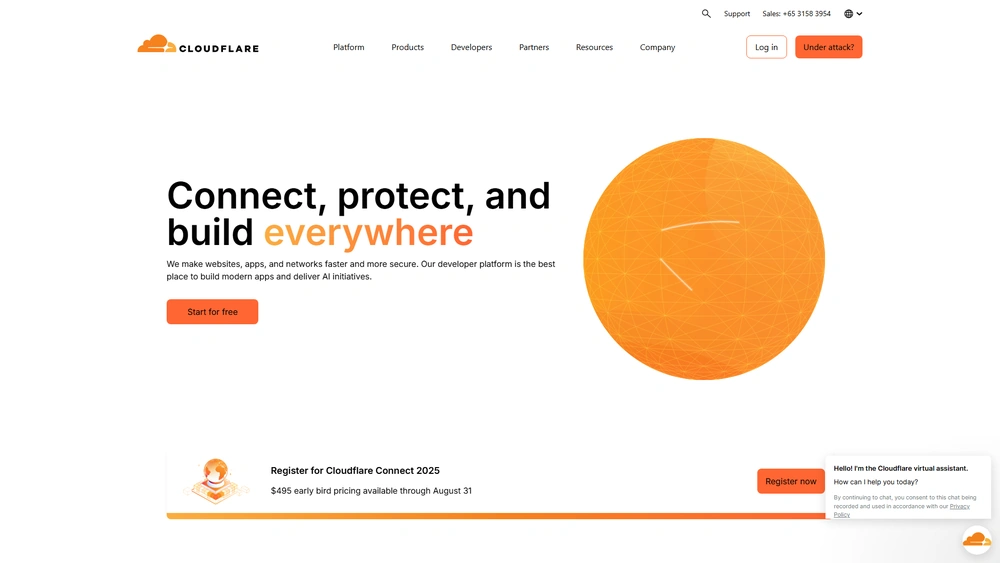Cloudflare Overview & 2025 Industry Position
Cloudflare, a leading connectivity cloud platform, continues to evolve from its CDN roots into a full-stack web performance, security, and developer services leader. Trusted by millions of websites, APIs, and enterprise networks globally, its mission in 2025 is clear: to help build a better internet—one that’s fast, secure, and programmable at scale. The company’s integrated platform spans DDoS protection, serverless development, website acceleration, zero trust security, and automated network modernization. In today’s world of distributed systems, AI workloads, and granular compliance demands, Cloudflare products offer a reliable, scalable solution stack.
From Launch to 2025: Cloudflare’s Journey
Founded in 2009 by Matthew Prince, Lee Holloway, and Michelle Zatlyn, Cloudflare launched out of a mission to make websites faster and more secure. Early traction came from its global CDN and web firewall offerings. Key milestones include:
- 2010: Official launch at TechCrunch Disrupt
- 2014: Introduced Universal SSL (free HTTPS for all)
- 2017: Launched Argo Smart Routing
- 2019: IPO on the NYSE under ticker NET
- 2020: Announced Cloudflare Workers for edge computing
- 2022: Rolled out Zero Trust security suite
In 2025, Cloudflare positions itself as the Connectivity Cloud—blending edge computing, security, and developer tools to power modern digital operations at massive scale.

Cloudflare Key Features
The 2025 Cloudflare platform spans four primary solution categories:
- Performance: CDN, image optimization, Argo Smart Routing, tiered caching
- Security: Web Application Firewall (WAF), Bot Management, DDoS protection, Zero Trust access
- Developer Platform: Cloudflare Workers (FaaS), R2 (object storage), Queues (event streaming), Durable Objects
- Connectivity: Magic WAN, Magic Transit, Network Interconnect, private routing
Standout innovations in 2025 include real-time AI threat scoring, edge-native LLM function harnessing, and programmable routing policies across multi-cloud and hybrid architectures.
Workflow & UX
Cloudflare’s dashboard offers a streamlined entry point for beginners and deep capabilities for advanced users. Feature categories are clearly grouped: Security, Performance, Workers & Pages, and Network. Core UI strengths include:
- Fast, global control propagation (changes update within seconds)
- In-dashboard analytics for traffic, threat, and routing stats
- Visual rule builders (Page Rules, WAF, and Access Policies)
- CLI and API options for power users (via Terraform or Wrangler)
Pro Tip: Use traffic analytics within Cloudflare’s dashboard to troubleshoot routing behavior and optimize cache policies across regions.
Cloudflare Pricing Analysis & Value Metrics
Cloudflare uses a freemium model for core services and usage-based pricing or flat-rate plans for business-grade capabilities.
| Plan | Monthly Cost | Includes |
|---|---|---|
| Free | $0 | DNS, CDN, Firewall (basic), SSL, Analytics |
| Pro | $20/site | WAF, image resizing, enhanced cache control |
| Business | $200/site | Advanced WAF, custom SSL, prioritized support |
| Enterprise | Custom | SLA, load balancing, Magic Transit, SASE |
Cloudflare pricing offers top-tier value, especially for startups and midsize tech companies due to its free tier and scalable pay-as-you-grow model.
Competitive Landscape
| Feature | Cloudflare | Akamai | Fastly |
|---|---|---|---|
| Free Tier | Yes | No | Limited |
| Zero Trust | Integrated | Extra Add-On | Partial |
| Developer Tools | Workers, R2, D1 | Limited | Compute@Edge |
| Ease of Use | Streamlined | Complex | Intermediate |
While Cloudflare offerings target a broader audience, Akamai suits larger media delivery networks, and Fastly appeals to performance-first content platforms.
Use Cases
Cloudflare shines in:
- SMBs: Low-cost web acceleration and protection
- Enterprises: Zero Trust adoption, global network scaling
- E-commerce: Site speed, bot blocking, PCI compliance
- SaaS / Dev Teams: Edge deployment with Workers, seamless CI/CD
Integrations
Cloudflare’s ecosystem connects with 50+ platforms, including:
- CMS: WordPress, Shopify, Magento
- DevOps: GitHub, Terraform, Vercel
- CRM & ERP: Salesforce, ServiceNow, Workday
- External APIs: Stripe, Twilio, OpenAI
These integrations amplify automation, improve latency, and simplify compliance via a unified observability layer.
Pros & Cons
- Pros
- Generous free tier and predictable pricing
- Unified platform: security, performance, and development
- Fast-growing edge and AI inference capabilities
- Highly programmable: APIs, Workers, Git integrations
- Cons
- Some dashboard sections feel advanced for newcomers
- R2 and D1 features still maturing compared with AWS S3 or PostgreSQL
- App-specific support limited to higher pricing tiers
Final Thoughts
Cloudflare’s 2025 platform is a stellar option for startups scaling globally, developers deploying edge-native apps, and enterprises seeking secure, fast end-to-end infrastructure. Strengths in programmability, pricing clarity, and a unified system make it stand out—even when compared to legacy CDNs or isolated security solutions. Trade-offs exist: learning curve, occasional feature gaps—but for most, the value outweighs the compromise.
Cloudflare FAQ
Yes, Cloudflare’s Free plan includes basic DNS, SSL, CDN, and DDoS protection for personal websites.
It’s a suite of tools including secure access, device posture checks, and encrypted tunnels that verify every connection request before granting access.
Cloudflare Workers run closer to end-users on edge nodes, with lower latency and no cold starts, while AWS Lambda is more mature, but centralized.
Yes, Cloudflare offers enterprise options with support for GDPR, SOC 2 Type II, and configurable data localization for compliance-sensitive use cases.
Absolutely. Cloudflare integrates seamlessly with WordPress for faster loading, automatic SSL, and enhanced security with minimal configuration.